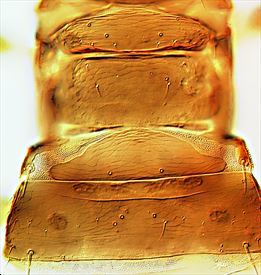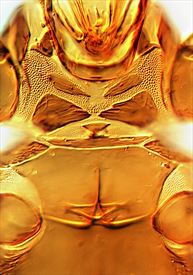Distinguishing features
Both sexes micropterous, female rarely fully winged. Female with body, legs, and antennae brown to dark brown, tarsi, base of antennal segment III, and distal third of tube pale; major setae not dark brown; fore wings (when present) pale. Head elongate, projecting in front of eyes; cheeks constricted behind eyes and basally; dorsal surface finely sculptured laterally and posteriorly; ocelli reduced; compound eyes with about 30 facets, sometimes larger dorsally than ventrally; postocular setae acute, about as long as distance between eyes; postocellar setae about half this length; maxillary stylets wide apart, extending into head about halfway to compound eyes. Antennae 8-segmented; IV with pedicel variable in length; VII and VIII not closely joined; segment III with 2 sense cones, IV with 4. Pronotum with faint lines of sculpture laterally and posteriorly; major setae acute; epimeral sutures complete; basantra present. Metanotum faintly reticulate; metathoracic sternopleural sutures absent. Fore tarsal tooth absent. Fore wing lobe shorter than thorax width. Pelta broad; tergites III–VI each with a pair of almost straight wing-retaining setae; tergite IX posteromarginal setae acute, almost as long as tube; tube shorter than head, constricted at apex. Macroptera.with ocelli well developed; compound eyes with about 50 facets; fore wing with 3 major sub-basal setae and 12–17 duplicated cilia; wing retaining setae straight on tergites II and III, curved or sigmoid on IV–VI.
Male microptera similar to female, but fore tarsal tooth well developed.
Related species
The genus Nesothrips includes 31 species, of which 6 are endemic to New Zealand, 13 are from Australia, 9 described from various Pacific islands, and 3 from southeast Asia. Unlike most species of Nesothrips, the slender body of badius is presumably adapted to living at the base of grasses. Presumably from Australia, it is not closely related to the New Zealand endemic species in this genus. It was referred to the genus Carientothrips at one time (Mound & Walker, 1986), but membership of that genus is now restricted to species with the unusual character state of maxillary palps with the basal segment much longer than the distal segment (Eow et al., 2014).
Biological data
Feeding on fungal spores at the base of grasses and in leaf litter.
Distribution data
Widespread in eastern Australia and presumably introduced to New Zealand (ND, AK, CL, TO / SD, MB, KA, MK, CO).
Family name
PHLAEOTHRIPIDAE, IDOLOTHRIPINAE
Species name
Nesothrips badius (Hood)
Original name and synonyms
Cryptothrips badius Hood, 1918: 143.
Carientothrips badius (Hood) Mound 1974: 127
Elaphrothrips apterus Girault, 1928: 2.
References
Eow LX, Mound LA, Tree DJ & Cameron SL (2014) Australian species of spore-feeding Thysanoptera in the genera Carientothrips and Nesothrips (Phlaeothripidae: Idolothripinae). Zootaxa 3821 (2): 193–221.
Mound LA & Walker AK (1986) Tubulifera (Insecta: Thysanoptera). Fauna of New Zealand 10: 1–140.



